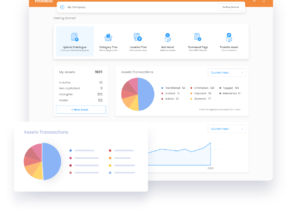Benefits of the Fixed Asset Software at the Hospitals
Utilizing the smart fixed assets solution that will add more control to the hospitals and health care providers. Many hospitals face a major challenge in keeping control of the whereabouts of their fixed assets; this brief document is describes the smart features of our solution Mojodat, how it helps solve this problem, and what the benefits of doing that can be. Behind our smart solution is a huge experience in fixed assets management, specifically in the health sector.

The Gap
Many of the acquired assets are registered by the owning departments in these institutions and get classified by accounting and bookkeeping in categories such as office furniture, computer equipment, medical equipment etc.. This process mostly ends up aggregating these assets into generic categories. This can create a big gap between the financial records of assets and what is actually on the ground. This leads to the ghost assets problem.
Ghost Assets
Ghost assets are fixed assets recorded in the financial register that do not exist in any of the institution’s premises. Over the years of the life of an institution, the gap between the financial records of the fixed assets and what still actually located in stores or working sites grows; ghost assets accumulate. Thus, the institutions pay large money for unnecessary maintenance and insurance fees (and in some countries asset taxes) on assets that do not exist anymore in an institution.
Why are the barcode labels important?
Most financial and Hospital Information System (HIS systems), including big ERP systems, do not record individual asset barcodes, therefore, each institution must separately manage their assets in accordance with applicable standards, and to acquire the appropriate software and devices to allow full control on the inventory process, the custodies and transfers. Some institutions also go beyond the use of regular barcode labels, as they use more advanced technologies such as RFID (Radio Frequency Identification) labels or advanced labels based on the Internet of Things (IoT).
When should advance technology be utilized in controlling fixed assets?
To properly utilize the radio label techniques, we would advise hospitals to acquire portable devices (Handheld) with appropriate software for their work, which is properly connected with the institution’s ERP and HIS systems. We would also advise them to install RFID sensors on important gates like what we see in clothing stores, but in a hidden way.
What do we do with the assets that cannot be labeled with a barcode?
Some fixed assets cannot be labeled with a barcode. Some of them are intangible and others are tangible but not counted (mass quantity of cheap assets). There are also some tangible and countable fixed assets that are not easily accessible to be traced through barcodes, such as surveillance cameras well above ground level, light fittings, and so on. For this type of assets, it is recommended to tag them with virtual tags, which are usually generated by specialized software for this purpose, which alerts the person that will do the counting using the mobile device to consider and monitor them.
Non-capitalized Assets
Technicians who place barcode labels on assets often face the problem of distinguishing between the fixed asset and the consumable material that is similar to a fixed asset in shape and function. Therefore, we advise to manage this type of materials as a Non-Capitalized Assets and to tag them in the same way of treating fixed assets, which saves lots of time and effort during the ongoing inventory operation, however, the fixed asset system should exclude this type of assets from any financial treatment.
In the case of materials that are not owned by the company, such as assets that are rented or provided without a price, like gifts or donation, it is highly recommended to track and inventory them, even though they are not present in the financial management records as assets, with the aim of controlling them from loss and to facilitate the task of the inventory takers who may not be able to distinguish the owned assets from non-owned one.
Managing or tracking fixed assets
It is the responsibility of the management to ensure that the policies and procedures in the institution are set correctly and are appropriate for the company’s business and that they include the appropriate procedures for acquiring fixed assets of all kinds, procedures for transfers, custodies, inventory, destruction, writing off and other controls that prevent any gap in tracking the life cycle of any type of assets. After making sure that these procedures are developed, the management of institutions must ensure that a professional team is assigned to place the appropriate barcode labels on the assets if they do not exist and then acquire fixed asset tracking software like Mojodat with the need for an advanced mobile system to allow any operation to be carried out and monitor using the mobile from anywhere near the asset location. Finally, asset management systems must be integrated with financial and HIS systems to prevent any disruption between the financial record of assets and their physical management.
Subscribe to read the full article below.

